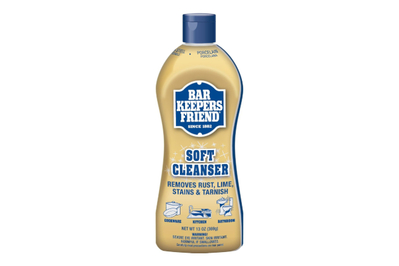Growing up, one of my designated chores was cleaning the bathrooms before company came over. While many kids might consider this a ghastly sentence, I took pride in the fact that my parents said I was really good at it. I much preferred it to doing the dishes, folding laundry, or raking the leaves. I could close the bathroom door, put on my headphones, and ignore the holiday-stress-induced storm my mom was whipping up on the other side.
Today, I’m not usually the one in my household who cleans the bathroom. That task has been delegated to my partner, and he’s got it down to the same science I did. This is a relief to me because now I’m channeling my mother’s chaotic energy by building overly complex canapés and overthinking the drink station when we have people over.
That’s why, for quite some time, I didn’t notice that our toilet was plagued by brownish mineral deposits around the rim, not to mention the faintly pink bacteria buildup that appears frequently along the waterline. It’s gross, yes, but it’s also just … part of having a toilet. Indoor plumbing is all fun and games until it’s time to clean it, right?
I tried scrubbing the rim of the toilet with our usual Method Antibacterial Toilet Bowl Cleaner, but it did next to nothing for the stains. Then I bought some Clorox Toilet Bowl Cleaner with bleach, and while it worked slightly better than the Method cleaner, I was still left with brown marks around the rim. Both products are disinfectants, so the toilet was cleaner than before, but they didn’t address my main gripe: the stains.
In my frustration, I shook some powdered Bar Keepers Friend into the bowl, and within seconds I noticed a difference.
(These trials were done on separate days—Bar Keepers Friend shouldn’t be mixed with any product containing bleach, as this can create toxic chlorine gas.)
Staff pick

Bar Keepers Friend (BKF, as it’s called around these parts) is a mainstay in my home. It’s incredible at getting even the most hopeless-looking stainless steel and enameled cast-iron pans clean, it’s great for scouring the oven, and it gets my stainless steel sink sparkling like brand-new.
It’s a longtime favorite of other Wirecutter staffers, too. Editorial director Christine Cyr Clisset has shined up sinks, faucets, enameled Le Creuset cookware, and stove-burner drip pans (along with her All-Clad stainless steel skillets, of course) with BKF. Home decor writer Joshua Lyon, for his part, has used this scrubbing wonder to restore a porcelain farmhouse sink in a 1924 cabin to its original glory, and even removed set-in adhesive stains from 1930s porcelain tile that previous owners had covered in carpet.
But despite porcelain being listed right on the canister as a use case for BKF, it didn’t occur to me that it might be a highly effective toilet bowl cleaner until I was faced with the persistent toilet stain situation. (I hate to even type those words.)
I assumed it was too harsh for the toilet and that the chemicals or grit would wear down the glaze, but as it turns out, it’s totally okay for use on the commode. It works particularly well on the toilet because it’s slightly abrasive but not gritty enough to damage the porcelain, and it contains oxalic acid, which breaks down rust and mineral stains. This combination is what works overtime on set-in, stuck-on stains—the acid breaks them down, and the granular texture buffs them away.

Since this miraculous discovery about a year ago, I’ve swapped the powdered formula for the Soft Cleanser version of BKF (which uses the same chemical with the addition of water in the formula) because it’s easy to squirt around the bowl like a traditional liquid toilet cleaner. For really old or stubborn stains though, I’ll form a paste with the original powder and a bit of water and let it sit on the stains before scrubbing.
Technically, BKF doesn’t recommend leaving the product on for longer than a minute before wiping it off, and Redditors have reported discoloration on some surfaces. That said, BKF recommends patch testing in an inconspicuous spot before going to town with a full slather. For what it’s worth, I and other Wirecutter staffers have exceeded this time limit and have not had any issues.

Bear in mind that BKF isn’t a disinfectant, so it won’t kill bacteria inside your toilet bowl. Since toilets are wet environments that can harbor bacteria, we do recommend regularly cleaning them with a disinfectant, such as Lysol Bleach Free Hydrogen Peroxide Toilet Bowl Cleaner for the bowl and Clorox Clean-Up Cleaner + Bleach for the outside of the bowl, tank, seat, and handle. Again, Bar Keepers Friend shouldn’t be mixed with any product containing bleach, as this can create toxic chlorine gas.
The author of our guide to cleaning a toilet, staff writer James Austin, explains that disinfectants are most effective when they’re not diluted by water in the toilet bowl. The easiest way to drain the bowl, he says, is by quickly dumping about a half gallon of water into the bowl, aiming toward the back, which will trigger the flushing action and drain the water without filling the bowl back up.
Even though it seems like I always have a new reason to fiercely swear by Bar Keepers Friend, the breakthrough that it removes those horrid toilet stains has officially topped my list. Now I never need to worry about the toilet when company comes over—even unannounced.
This article was edited by Megan Beauchamp, Maxine Builder, and Christine Cyr Clisset.





